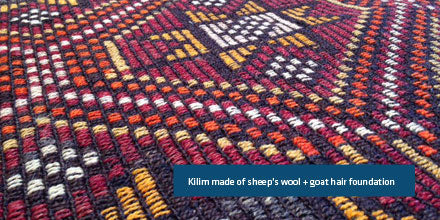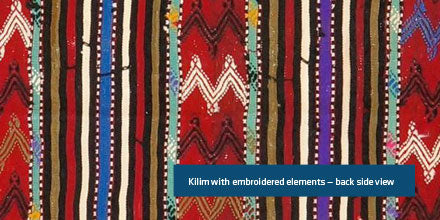Pick the Perfect Kilim
Kilims are awesome. They're lightweight, full of unique personality and character, easy to clean, and an affordable option in the world of handmade rugs. (Not convinced? Read more here) Like all things, there are certain factors you should consider when choosing a kilim for your home or office or magical glamping site.
How soft should it be?
Kilims are made of natural materials, like wool, cotton, sisal, goat hair and jute. Sheep's wool and cotton create the softest kilims, while goat hair, jute and sisal tend to be a little rougher.
Why this matters: For bedrooms, living rooms or places you want to lie around on the floor, we'd recommend going for something a little on the softer side. Natural, coarse kilims are great for high traffic areas and entry ways.
Why this matters: For bedrooms, living rooms or places you want to lie around on the floor, we'd recommend going for something a little on the softer side. Natural, coarse kilims are great for high traffic areas and entry ways.
Should it be reversible?
Most kilims have the exact same design on the front as they do on the back; it's a byproduct of the basket-weaving-style technique used to make flatweaves. On some kilims, the weaver has included an additional texture by hand-embroidering a detail or portion of the rug, which leaves a hand-stitched unfinished look on the back. On other kilims with a jute or goat hair foundation, the rug was woven in a way that there is a distinct front and back (ie. not reversible).
Why this matters: People may be looking for a kilim so that they can flip it over in the event of stains or wear and tear. If that's important to you, you will want to look for a kilim with a wool/cotton foundation that does not have embroidery.
Why this matters: People may be looking for a kilim so that they can flip it over in the event of stains or wear and tear. If that's important to you, you will want to look for a kilim with a wool/cotton foundation that does not have embroidery.
How large should it be?
Kilims are part of a long tradition of hand-crafted goods made in homes, villages and by nomadic tribes. Because they were more of a cottage industry and less of a formal workshop one, the looms used to weave them tend to be smaller, which is why it's uncommon to see flatweaves in very large sizes. That said, that doesn't mean villagers and nomads didn't have a need for big rugs — they did. But rather than weaving a bigger rug, they would sew together two smaller rugs.
Why this matters: If you're looking for an authentic kilim and need to cover a large area, you should consider a double-wide like I just described, or try layering several smaller kilims.
Why this matters: If you're looking for an authentic kilim and need to cover a large area, you should consider a double-wide like I just described, or try layering several smaller kilims.
How wet will it get?
Kilims (and most hand made rugs) can get wet — but it's also really, really important that they get dry. Natural fibers can become misshapen or even develop mold if they are not thoroughly dried out. Water can also cause dyes to bleed. Spot cleaning a rug is okay and so is an errant spill. All-over washing can be done at home but it's a bit trickier, and we recommend professional cleaning in those instances.
Why this matters: If you're considering a rug for an area prone to water (bathroom, your glamp site) you will need to factor in letting it dry out in the sun if it gets doused.
Now that you've covered the main factors to consider when picking you're kilim, you're ready to get shopping!

SHOP MORE KILIMS
Featured Products
2 Comments
Anonymous
Hi Tiffini!
Apologies for the late reply — your comment was mislabeled on our end, and we missed it!
We have a number of kilims AND will be posting a new crop of them in accent sizes tomorrow.
We also offer a Concierge Consultation service which you can learn about here: http://www.floorplanrugs.com/pages/free-consultation
We’re happy to help you find the right combination of kilims for your space!
Tiffini Johnston
Where can I find kilims and have help mixing and matching them. I need at least 3 that blend in my home and am having trouble finding places to shop for them
X












Erin Eisinger
Author
Floorplan CEO and Co-Founder. Designer. Storyteller. Entrepreneur.